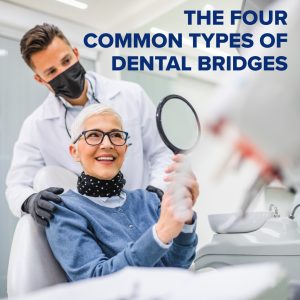The Four Types Of Dental Bridges
 Missing teeth can affect your smile, affecting both aesthetics and functionality. That is why at Advanced Dentistry by Design in Carson City, we offer dental crowns to replace your missing teeth and restore the beauty of your smile. Dental bridges are prosthetic devices that bridge the gap created by one or more missing teeth. They not only replace your teeth but also prevent neighboring teeth from shifting out of position, maintaining proper alignment and bite function. Dental bridges come in different types and can be used for different situations.
Missing teeth can affect your smile, affecting both aesthetics and functionality. That is why at Advanced Dentistry by Design in Carson City, we offer dental crowns to replace your missing teeth and restore the beauty of your smile. Dental bridges are prosthetic devices that bridge the gap created by one or more missing teeth. They not only replace your teeth but also prevent neighboring teeth from shifting out of position, maintaining proper alignment and bite function. Dental bridges come in different types and can be used for different situations.
Here are the four common types of bridges
- Traditional Bridges
These are the most common type of bridges, consisting of one or more pontics anchored by dental crowns placed over adjacent natural teeth.
- Cantilever Bridges
Unlike traditional bridges, which rely on support from both sides of the gap, a cantilever bridge is anchored on just one side. This makes it a suitable option in situations where there’s limited space or when the adjacent tooth is strong enough to bear the load.
- Maryland Bridges
Also known as resin-bonded bridges, Maryland bridges involve attaching a metal or porcelain framework to the backs of nearby teeth using resin cement. This method provides a reliable and simple solution for filling the gap left by missing teeth.
- Implant-Supported Bridges
For individuals with multiple missing teeth or insufficient natural teeth for support, implant-supported bridges are a viable option. Dental implants are surgically placed in the jawbone to serve as sturdy anchors for the bridge.
With various types available to suit your unique needs and preferences, bridges provide a long-term solution for improving oral health and overall well-being. Schedule an appointment with Carson City dentists, Dr. Euse and Dr. Wright at Advanced Dentistry by Design, who will be ready to provide you with a personalized treatment plan, ensuring a healthy smile.
Contact Advanced Dentistry by Design in Carson City today to schedule an appointment!
Disclaimer: The content of this blog is not intended to be a substitute for professional medical advice, diagnosis, or treatment. Always seek the advice of qualified health providers with questions you may have regarding medical conditions.
